- Ludisia Orchids: How to Successfully Care for Them at Home
- Introduction
- Lighting
- Temperature and Humidity
- Watering
- Potting Mix and Repotting
- Fertilizing
- Air Circulation
- Pest Control
- Conclusion
- Choosing the Right Environment for Ludisia Orchids
- Temperature
- Light
- Humidity
- Air Circulation
- Substrate
- Fertilizer
- Watering
- Potting and Repotting
- Lighting Requirements for Healthy Ludisia Orchids
- 1. Indirect Light
- 2. Bright, Filtered Light
- 3. North or East-Facing Windows
- 4. Monitor Light Intensity
- 5. Use Artificial Lighting
- 6. Rotate Plants
- Temperature and Humidity Considerations
- Temperature
- Humidity
- Air Circulation
- Temperature and Humidity Sensors
- Watering Ludisia Orchids: Tips and Mistakes to Avoid
- 1. Find the Right Balance
- 2. Consider the Potting Mix
- 3. Use the Soak and Dry Method
- 4. Avoid Overwatering
- 5. Be Mindful of Temperature and Humidity
- 6. Avoid Watering the Leaves
- 7. Monitor the Plant’s Health
- Fertilizing Ludisia Orchids: What You Need to Know
- Why Fertilize Ludisia Orchids?
- When to Fertilize Ludisia Orchids
- Types of Fertilizers for Ludisia Orchids
- How to Fertilize Ludisia Orchids
- Signs of Over-Fertilization
- Additional Tips for Fertilizing Ludisia Orchids
- Repotting Ludisia Orchids: When and How to Do It
- When to Repot
- How to Repot
- Aftercare
- Common Pests and Diseases: How to Identify and Treat Them
- Pests
- Diseases
- Prevention and Maintenance
- Tips and Tricks for Proper Ludisia Orchid Care
- 1. Light
- 2. Temperature
- 3. Humidity
- 4. Watering
- 5. Fertilizer
- 6. Potting
- 7. Pruning
- 8. Air Circulation
- 9. Regular Inspections
- 10. Rest Period
- 11. Companion Plants
- Q&A:
- How often should I water my Ludisia orchid?
- What kind of light does Ludisia orchid require?
- Can I grow Ludisia orchid in a regular potting mix?
- How often should I fertilize my Ludisia orchid?
- What is the ideal temperature range for Ludisia orchids?
- How do I propagate Ludisia orchids?
- Why are the leaves of my Ludisia orchid turning yellow?
- Video: Ludisia discolor (Jewel Orchid) Houseplant Care — 217 of 365
Ludisia orchids, also known as the jewel orchids, are a stunning addition to any indoor garden. These unique orchids are prized for their velvety leaves, which often have stunning patterns in shades of deep burgundy and green. While they may not produce the showy flowers that some other orchid varieties are known for, their foliage more than makes up for it. With proper care, ludisia orchids can thrive and bring a touch of exotic beauty to your home.
Lighting is one of the most important factors in successfully growing ludisia orchids. These orchids prefer bright, indirect light. Placing them near a window with filtered light or using artificial lights, such as fluorescent or LED grow lights, can help provide the ideal lighting conditions they need.
Temperature and Humidity are also crucial for ludisia orchids. They prefer temperatures between 65°F and 75°F (18°C and 24°C) during the day and slightly cooler temperatures at night. Additionally, these orchids thrive in high humidity, which can be achieved by placing them on a tray filled with water and pebbles or using a humidifier.
Watering and Feeding ludisia orchids require regular watering to keep their roots moist but not waterlogged. It’s best to water them when the top inch of the soil feels dry. During the growing season, fertilize these orchids every two weeks with a balanced orchid fertilizer diluted to half the recommended strength.
With the right care and attention, ludisia orchids can be a rewarding addition to your indoor garden. Their unique foliage and easy care requirements make them a great choice for even novice orchid enthusiasts. So why not bring a touch of exotic beauty to your home with these stunning jewel orchids?
Ludisia Orchids: How to Successfully Care for Them at Home
Introduction
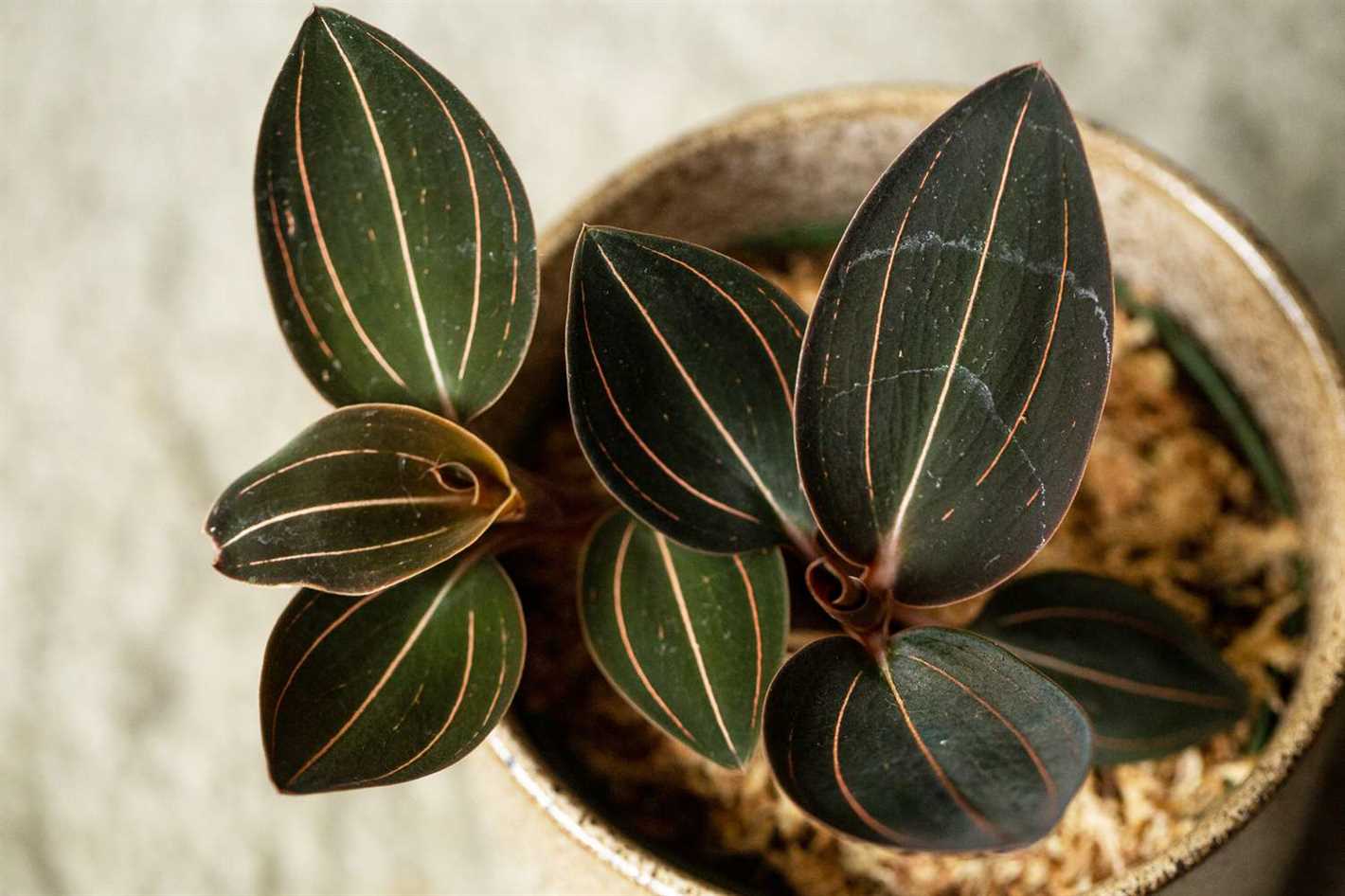
Ludisia orchids, commonly known as jewel orchids, are beautiful and exotic plants that can be successfully grown at home with proper care. Native to Southeast Asia, these terrestrial orchids are loved for their velvety foliage and stunning patterns. In this guide, we will provide you with tips and advice on how to care for Ludisia orchids and ensure their successful growth in a home environment.
Lighting
Ludisia orchids prefer bright, indirect light. They can tolerate some shade, but too much shade may result in poor growth and lack of blooms. Place your Ludisia orchids near a window with filtered light, away from direct sunlight. If you notice the leaves turning yellow or scorched, it may indicate that the plant is receiving too much light.
Temperature and Humidity
Ludisia orchids thrive in warm and humid conditions. Ideal temperatures range between 65°F (18°C) and 80°F (27°C) during the day, and slightly cooler temperatures at night. To increase humidity, place a tray filled with water near the orchid or use a humidifier. Misting the foliage occasionally can also help create a humid microclimate around the plant.
Watering
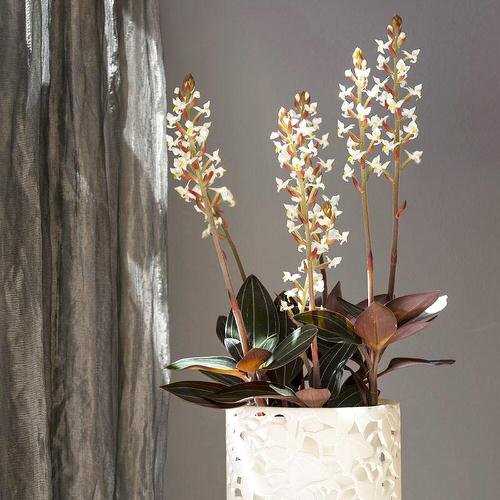
Proper watering is crucial for the health of Ludisia orchids. They prefer to be kept evenly moist, but not soaking wet. Water the plant when the top inch of the potting mix feels dry. Avoid overwatering as it can lead to root rot. Allow excess water to drain completely and never let the orchid sit in standing water.
Potting Mix and Repotting
Ludisia orchids thrive in a well-draining potting mix that retains some moisture. A mixture of orchid bark, sphagnum moss, and perlite or perlite and peat moss can be suitable. Repot the orchid every 1-2 years, preferably in spring, using a slightly larger pot to accommodate its growth. Be gentle when handling the roots to avoid damage.
Fertilizing
Ludisia orchids benefit from regular fertilization during the growing season. Use a balanced, water-soluble orchid fertilizer diluted to half-strength. Apply the fertilizer every 2-4 weeks, following the manufacturer’s instructions. Reduce the frequency during winter when the orchid is in its resting phase.
Air Circulation
Adequate air circulation is important for Ludisia orchids to prevent the growth of fungal diseases. Ensure that the plant has good airflow around it by not crowding it with other plants. Running a fan in the room can also help improve air circulation.
Pest Control
Ludisia orchids can be susceptible to common orchid pests such as aphids, mealybugs, and spider mites. Regularly inspect your orchid for any signs of pests and take appropriate measures to control them. In mild cases, wiping the foliage with a damp cloth may be sufficient. For more severe infestations, use an orchid-friendly insecticide.
Conclusion
With the right care and conditions, Ludisia orchids can thrive and bring beauty to your home. By providing the right amount of light, temperature, humidity, watering, and fertilization, your Ludisia orchids will reward you with their exquisite foliage and occasional delicate blooms. Remember to observe and adjust your care routine based on the specific needs and behavior of your individual orchid. Happy growing!
Choosing the Right Environment for Ludisia Orchids
Ludisia orchids, also known as jewel orchids, are tropical plants that require specific conditions in order to thrive. When creating an environment for your Ludisia orchids, there are a few key factors to consider:
Temperature
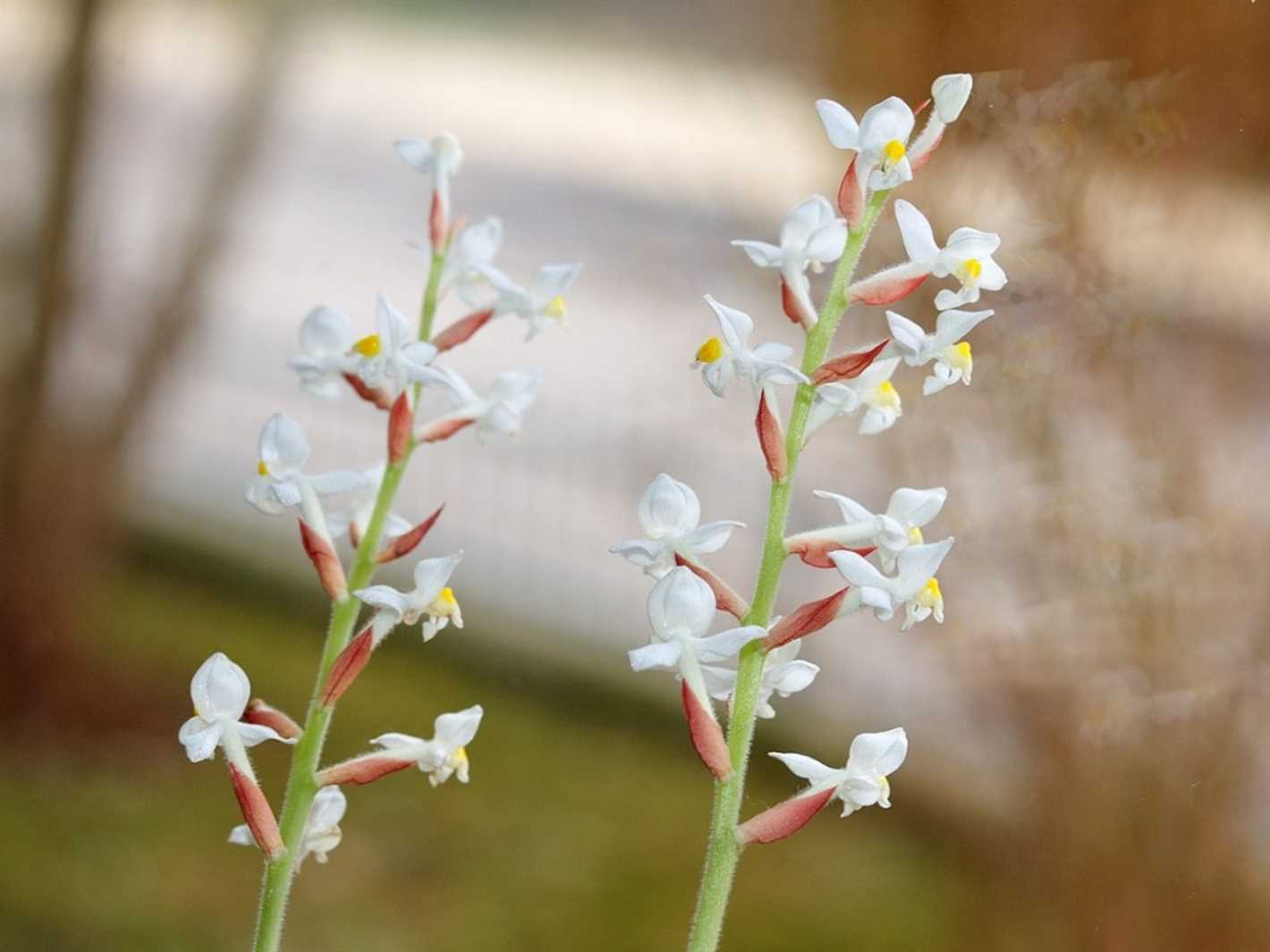
Ludisia orchids prefer temperatures between 65-80°F (18-27°C) during the day and slightly cooler temperatures at night. It is important to avoid extreme temperature fluctuations, as this can stress the plant and affect its growth.
Light
Ludisia orchids are shade-loving plants and can suffer from direct sunlight. It is best to provide them with indirect or filtered light. Placing them near a north or east-facing window is ideal, as it will provide them with the right amount of light without causing damage to their leaves.
Humidity
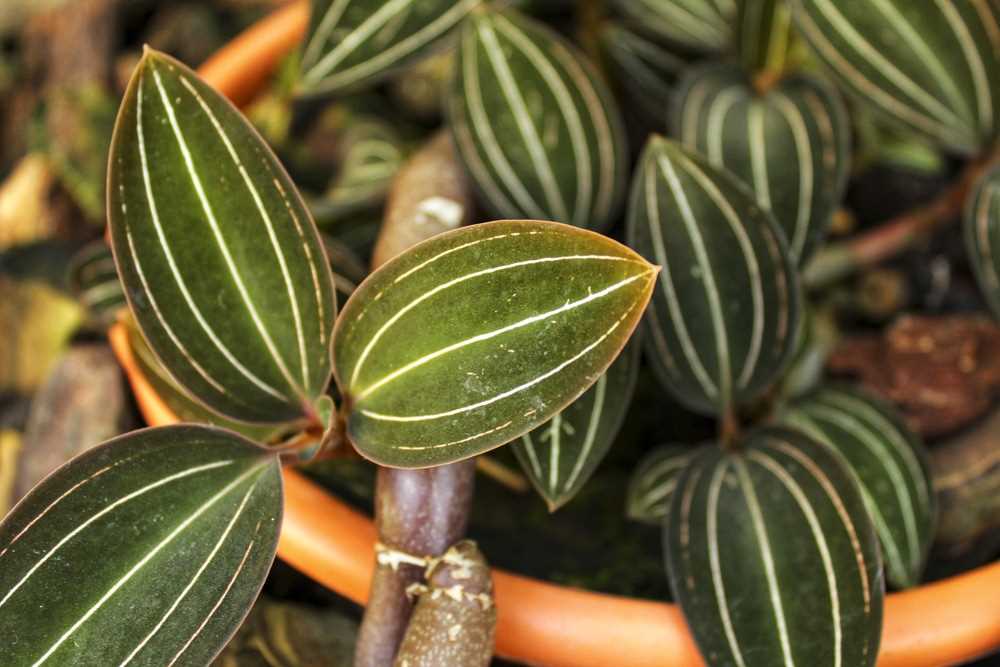
Ludisia orchids thrive in high humidity environments, similar to their natural habitats in the tropics. Aim to maintain humidity levels between 50-70%. You can achieve this by using a humidifier, placing the orchids on a tray filled with water and pebbles, or misting them regularly.
Air Circulation
Adequate air circulation is essential for Ludisia orchids to prevent the development of fungal diseases. Ensure that the area where you keep your orchids has good ventilation. You can also use a fan to improve air circulation.
Substrate
Ludisia orchids prefer a well-draining substrate that retains moisture but does not become waterlogged. A mix of orchid bark, sphagnum moss, and perlite is suitable for providing the necessary drainage and moisture retention. Avoid using regular potting soil, as it can hold too much water and suffocate the roots.
Fertilizer
Provide your Ludisia orchids with a balanced orchid fertilizer diluted to half the recommended strength. Fertilize them every 2-4 weeks during the growing season (spring and summer) and reduce or stop fertilizing during the dormant period (fall and winter).
Watering
Ludisia orchids prefer to be kept evenly moist but not soggy. Water them when the top inch of the substrate feels dry to the touch. Avoid letting them sit in standing water, as this can lead to root rot.
Potting and Repotting
When potting or repotting Ludisia orchids, choose a pot that is slightly larger than the current one to allow for growth. Ensure that the pot has good drainage holes. Repotting should be done every 1-2 years, preferably in spring, using fresh orchid substrate.
| Conditions | Temperature | Light | Humidity | Air Circulation |
|---|---|---|---|---|
| Optimal | 65-80°F (18-27°C) | Indirect or filtered light | 50-70% humidity | Good ventilation |
By providing Ludisia orchids with the right environment, you can ensure their health and encourage their beautiful foliage to thrive.
Lighting Requirements for Healthy Ludisia Orchids
Ludisia orchids require a balance of light to grow and thrive. Here are some lighting requirements to keep in mind when caring for Ludisia orchids at home:
1. Indirect Light
Ludisia orchids prefer bright, indirect light. Avoid placing them in direct sunlight as it can scorch their leaves and cause damage.
2. Bright, Filtered Light
Find a spot in your home that receives bright, filtered light, such as near a window with sheer curtains. This will provide the orchids with the necessary amount of light without subjecting them to direct sun exposure.
3. North or East-Facing Windows
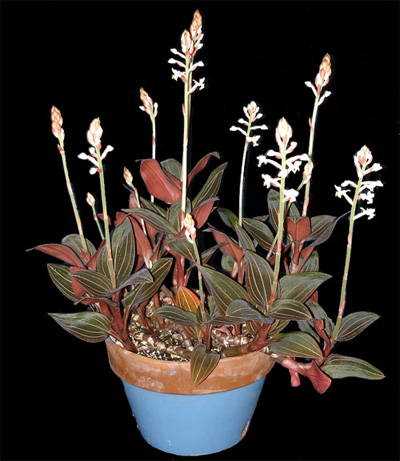
If possible, place your Ludisia orchids near north or east-facing windows. These directions typically provide the right balance of light for orchid growth without the intense afternoon sun that west or south-facing windows may have.
4. Monitor Light Intensity
Keep an eye on the intensity of light your Ludisia orchids receive. If the leaves appear burned or overly yellow, it may indicate that they are getting too much light. On the other hand, if the leaves are dark green and the plant is not growing well, it may indicate that the orchids need more light.
5. Use Artificial Lighting
If you don’t have access to adequate natural light, you can supplement with artificial lighting. Use fluorescent lights or LED grow lights designed for orchids. Place them above the orchids at a distance that provides the right amount of light intensity.
6. Rotate Plants
To ensure even light distribution, periodically rotate your Ludisia orchids. This will prevent any one side of the plant from receiving too much or too little light, promoting balanced growth.
By providing the right lighting conditions, you can help your Ludisia orchids thrive and produce beautiful, healthy foliage. Remember to monitor your orchids’ response to light and make adjustments accordingly.
Temperature and Humidity Considerations
Ludisia orchids require specific temperature and humidity conditions to thrive. Here are some important considerations:
Temperature
The ideal temperature range for Ludisia orchids is between 60°F (15°C) and 80°F (27°C). They can tolerate slightly lower or higher temperatures, but sudden temperature fluctuations should be avoided as they can stress the plants.
During the daytime, a temperature of around 70°F (21°C) is ideal, while at night, it is recommended to lower the temperature by a few degrees. This diurnal temperature difference can stimulate healthy growth.
Humidity
Humidity plays a crucial role in the growth of Ludisia orchids. They prefer a humidity level of around 60-70%. If the air is too dry, the orchids may have difficulty absorbing moisture through their aerial roots, leading to dehydration.
To increase humidity, you can place a tray filled with water near the orchids or use a humidifier. Misting the leaves with water can also help provide additional moisture.
Air Circulation
Although Ludisia orchids appreciate high humidity, it is important to provide adequate air circulation to prevent the development of fungal and bacterial diseases. A gentle fan or an open window can help maintain proper air flow.
However, avoid placing the orchids in drafty areas or where they will be exposed to direct airflow, as this can cause stress to the plants.
Temperature and Humidity Sensors
Using temperature and humidity sensors can be helpful in maintaining the ideal conditions for Ludisia orchids. These sensors can provide real-time data, allowing you to make adjustments as needed to ensure the orchids’ well-being.
| Temperature | Humidity |
|---|---|
| 60°F – 80°F (15°C – 27°C) | 60-70% |
By carefully monitoring and adjusting the temperature and humidity levels, you can create a favorable environment for your Ludisia orchids, promoting their growth and overall health.
Watering Ludisia Orchids: Tips and Mistakes to Avoid
Ludisia orchids, also known as jewel orchids, are beautiful houseplants that require specific care in order to thrive. One crucial aspect of Ludisia care is proper watering. Understanding the right watering techniques and avoiding common mistakes can help ensure the health and longevity of your Ludisia orchids. Here are some tips and mistakes to avoid when watering Ludisia orchids:
1. Find the Right Balance
When it comes to watering Ludisia orchids, finding the right balance is key. These plants prefer a slightly damp growing medium, but they don’t like to stay sitting in water. Overwatering can lead to root rot and other issues, while underwatering can cause the plant to wilt and die. The goal is to keep the roots moist without letting them become waterlogged.
2. Consider the Potting Mix
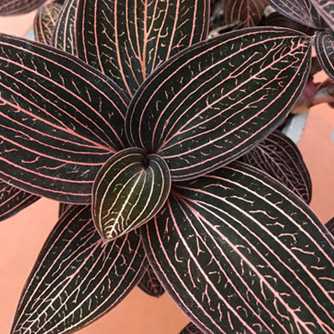
The type of potting mix you use for your Ludisia orchids can affect their watering needs. Orchid-specific potting mixes, which are typically composed of bark, sphagnum moss, and perlite, are well-draining and allow for proper airflow. This helps prevent water from stagnating in the roots. Avoid using regular potting soil, as it tends to retain moisture and can suffocate the orchid’s roots.
3. Use the Soak and Dry Method
One effective watering method for Ludisia orchids is the soak and dry method. This involves thoroughly watering the plant until water drains out of the bottom of the pot, and then allowing the top inch or so of the potting mix to dry out before watering again. This mimics the natural cycle of rain followed by drying in their native habitats.
4. Avoid Overwatering
Overwatering is one of the most common mistakes made when caring for Ludisia orchids. Remember that these plants prefer slightly moist conditions, but they don’t like to sit in water. Always check the moisture level of the potting mix before watering and adjust your watering schedule accordingly. A moisture meter can be a helpful tool for determining when it’s time to water.
5. Be Mindful of Temperature and Humidity
The temperature and humidity levels in your home can impact the watering needs of your Ludisia orchids. Higher temperatures and lower humidity levels will cause the potting mix to dry out faster, which may require more frequent watering. On the other hand, cooler temperatures and higher humidity levels may result in slower drying and less frequent watering.
6. Avoid Watering the Leaves
When watering Ludisia orchids, it’s important to avoid wetting the leaves. While they do appreciate humidity, water droplets on the leaves can lead to fungal diseases and damage. Aim to water at the base of the plant, directly into the potting mix, and avoid getting water on the foliage as much as possible.
7. Monitor the Plant’s Health
Regularly monitoring the health of your Ludisia orchids can help you gauge their watering needs. Healthy roots are typically plump and firm, while overwatered roots may appear mushy or black. If you notice any signs of overwatering or underwatering, adjust your watering routine accordingly.
By following these watering tips and avoiding common mistakes, you can provide your Ludisia orchids with the right amount of moisture, promoting their growth and ensuring their overall health and beauty.
Fertilizing Ludisia Orchids: What You Need to Know
Why Fertilize Ludisia Orchids?
Ludisia orchids, also known as jewel orchids, are terrestrial orchids that require regular fertilization to thrive and produce healthy blooms. Fertilizing these orchids provides them with the essential nutrients they need to grow and develop properly.
When to Fertilize Ludisia Orchids
Fertilizing Ludisia orchids should be done during their active growing season, which is typically spring and summer. It’s best to avoid fertilizing during the dormant period in fall and winter. This ensures that the orchids receive the nutrients they need when they are actively growing.
Types of Fertilizers for Ludisia Orchids
When choosing a fertilizer for your Ludisia orchids, it’s important to use a balanced, water-soluble formula specifically designed for orchids. These fertilizers typically have equal proportions of nitrogen (N), phosphorus (P), and potassium (K). Look for a fertilizer with an N-P-K ratio of 20-20-20 or similar.
How to Fertilize Ludisia Orchids
Here are some tips for fertilizing Ludisia orchids:
- Dilute the fertilizer according to the instructions on the package. It’s best to use a weaker concentration than recommended, as orchids are sensitive to fertilizer burn.
- Water the orchids thoroughly before applying the fertilizer. This helps prevent root burn and ensures that the nutrients are evenly distributed.
- Apply the diluted fertilizer to the orchid’s soil or growing medium. Avoid getting the fertilizer on the leaves or aerial roots, as it can cause burns.
- Fertilize Ludisia orchids every 2-4 weeks during the growing season. Adjust the frequency based on the specific needs of your orchids.
Signs of Over-Fertilization
It’s important to be cautious when fertilizing Ludisia orchids, as over-fertilization can harm the plants. Signs of over-fertilization include leaf burning, stunted growth, a build-up of fertilizer salts on the soil surface, and brown or black roots.
Additional Tips for Fertilizing Ludisia Orchids
- Always follow the instructions on the fertilizer package.
- Avoid fertilizing orchids when they are experiencing stress, such as after repotting or during extreme temperature fluctuations.
- Flush the orchid’s growing medium with water occasionally to prevent a buildup of fertilizer salts.
By fertilizing your Ludisia orchids properly, you can ensure that they receive the nutrients they need to grow and bloom beautifully.
Repotting Ludisia Orchids: When and How to Do It
Repotting a Ludisia orchid is an essential part of its care routine. It allows the plant to get fresh nutrients and ensures proper growth and development. Here are some tips on when and how to repot your Ludisia orchids:
When to Repot
Ludisia orchids typically need to be repotted every one to two years. Signs that your orchid may need repotting include:
- Overcrowded roots: If your orchid’s roots are tightly packed in the pot and have no room to grow, it’s time to repot.
- Stunted growth: If your orchid has stopped growing or its new growth is significantly smaller than before, repotting may be necessary.
- Deteriorating potting media: If the potting mix has broken down, become compacted, or holds too much moisture, it’s time to repot.
How to Repot
- Choose the right pot: Select a pot that is slightly larger than the current pot, allowing room for growth and new roots.
- Prepare the potting mix: Use a well-draining potting mix suitable for orchids. A mix of bark, perlite, and sphagnum moss is a good option.
- Remove the orchid from its pot: Gently slide the orchid out of its pot, being careful not to damage the delicate roots.
- Inspect the roots: Take a close look at the roots and trim any dead or rotting roots with a clean pair of scissors or pruning shears.
- Place the orchid in the new pot: Position the orchid in the center of the new pot, making sure the roots are spread out evenly.
- Add the potting mix: Carefully fill in the gaps with the potting mix, ensuring that the roots are covered but not buried too deeply.
- Water thoroughly: After repotting, give the orchid a thorough watering to settle the potting mix and hydrate the roots.
Aftercare
After repotting, it’s important to provide the right conditions for your Ludisia orchid to recover:
- Place the orchid in a well-lit spot, but avoid direct sunlight.
- Maintain a consistent temperature and humidity level.
- Water the orchid regularly, keeping the potting mix moist but not waterlogged.
- Avoid fertilizing immediately after repotting, as it may stress the plant.
- Monitor the orchid closely for any signs of stress or disease.
By following these guidelines, you can successfully repot your Ludisia orchids and promote healthy growth and blooming.
Common Pests and Diseases: How to Identify and Treat Them
Pests
While ludisia orchids are generally resistant to pests, they can still be susceptible to a few common ones. Here are some pests that you may encounter:
- Aphids: These small insects can suck sap from your ludisia orchids, causing stunted growth and distorted leaves. They are often found on the undersides of leaves. Regularly inspect your plants and use insecticidal soap or neem oil to control aphids.
- Mealybugs: Mealybugs are small, white, cottony insects that feed on the sap of plants. They can cause yellowing of leaves and stunted growth. Remove them manually with a cotton swab dipped in rubbing alcohol or use insecticidal soap.
- Spider mites: These tiny pests can spin webs and cause yellowing, speckling, and wilting of leaves. Inspect the foliage for fine webbing and treat with insecticidal soap or neem oil.
- Scale insects: Scale insects appear as small, oval-shaped bumps on the leaves and stems. They can cause yellowing, wilting, and leaf drop. Remove them manually with a cotton swab dipped in rubbing alcohol or use insecticidal soap.
Diseases
Ludisia orchids are generally disease-resistant, but they can still suffer from a few common diseases. Here are some diseases you should watch out for:
- Fungal infections: Root rot and leaf spot are common fungal infections in ludisia orchids. Overwatering and poor air circulation can contribute to these diseases. Treat fungal infections by improving drainage, reducing watering frequency, and applying a fungicide if necessary.
- Viral diseases: Viral diseases can cause stunted growth, distorted leaves, and discoloration. Unfortunately, there is no cure for viral diseases. Prevent the spread of viruses by practicing good sanitation and immediately removing and disposing of infected plants.
Prevention and Maintenance
Preventing pests and diseases is crucial for the health of your ludisia orchids. Here are some tips to keep your plants healthy:
- Provide proper air circulation by placing your orchids in a well-ventilated area.
- Avoid overwatering by allowing the top inch of soil to dry out before watering again.
- Inspect your plants regularly for any signs of pests or diseases.
- Quarantine new plants for a few weeks to ensure they are not carrying any pests or diseases.
- Use sterile tools when working with your orchids to prevent the spread of diseases.
- Remove dead or dying plant material promptly to prevent the growth of fungi and bacteria.
| Pest/Disease | Identification | Treatment |
|---|---|---|
| Aphids | Small insects found on the undersides of leaves | Insecticidal soap or neem oil |
| Mealybugs | Small, white, cottony insects | Remove manually or use insecticidal soap |
| Spider mites | Small pests that spin webs | Insecticidal soap or neem oil |
| Scale insects | Small, oval-shaped bumps on leaves and stems | Remove manually or use insecticidal soap |
| Fungal infections | Root rot and leaf spot | Improve drainage, reduce watering, apply fungicide if necessary |
| Viral diseases | Stunted growth, distorted leaves, discoloration | No cure, practice good sanitation, remove infected plants |
Tips and Tricks for Proper Ludisia Orchid Care
1. Light
Ludisia orchids prefer bright, indirect light. Avoid exposing them to direct sunlight, as it can scorch their delicate leaves. Place them near a north or east-facing window where they can receive gentle, filtered light.
2. Temperature
Maintain a temperature range of 65-75°F (18-24°C) during the day and around 55°F (13°C) at night for Ludisia orchids. Avoid placing them in areas with extreme temperatures or drafts, as it can stress the plants.
3. Humidity
Ludisia orchids have a preference for higher humidity levels. Place a tray with water near the orchids or use a humidifier to increase humidity in the air. Misting the leaves occasionally can also help maintain proper humidity levels.
4. Watering
Water Ludisia orchids when the top inch of the soil feels dry. Use room temperature water to thoroughly moisten the soil until water drains out of the pot’s bottom. Avoid allowing the orchid to sit in standing water, as it can lead to root rot.
5. Fertilizer
Feed Ludisia orchids with a balanced orchid fertilizer at half the recommended strength every two weeks during the growing season (spring and summer). Reduce feeding frequency to once a month during the dormant season (fall and winter).
6. Potting
Repot Ludisia orchids every 1-2 years, or when they outgrow their current pot. Use a well-draining orchid mix, such as a combination of bark, sphagnum moss, and perlite. Ensure the pot has proper drainage holes to prevent waterlogging.
7. Pruning
Remove any dead or yellowing leaves by gently pulling them off the plant. Trim any leggy or overgrown stems to encourage bushier growth. Sterilize pruning tools before use to prevent the spread of diseases.
8. Air Circulation
Good air circulation is essential for Ludisia orchids to prevent the growth of fungal diseases. Keep them in a well-ventilated area and avoid crowding them with other plants.
9. Regular Inspections
Regularly inspect your Ludisia orchids for signs of pests or diseases. Look for yellowing leaves, wilting, or unusual spots. If any issues are detected, take prompt action to prevent further damage.
10. Rest Period
Ludisia orchids go through a natural resting period during the fall and winter. During this time, reduce watering and fertilizing, and avoid repotting or disturbing the plant. Allow the orchid to rest and conserve energy for new growth in the spring.
11. Companion Plants
Consider pairing your Ludisia orchids with other humidity-loving plants, such as ferns or Calathea species. This can create a visually pleasing display and provide the ideal growing conditions for both plants.
By following these tips and tricks, you can ensure proper care for your Ludisia orchids and enjoy their beautiful foliage and flowers for years to come.
Q&A:
How often should I water my Ludisia orchid?
Ludisia orchids should be watered once a week during the growing season. It is important to keep the potting mix slightly moist but not overly wet.
What kind of light does Ludisia orchid require?
Ludisia orchids prefer bright, indirect light. They can tolerate some morning or evening sun, but direct sunlight should be avoided as it can scorch the leaves.
Can I grow Ludisia orchid in a regular potting mix?
Ludisia orchids thrive in a mix of well-draining orchid potting mix and sphagnum moss. This provides the necessary moisture retention while ensuring good air circulation to the roots.
How often should I fertilize my Ludisia orchid?
Ludisia orchids should be fertilized once a month during the growing season using a balanced orchid fertilizer. It is important to dilute the fertilizer to half or quarter strength to prevent burning the roots.
What is the ideal temperature range for Ludisia orchids?
Ludisia orchids prefer temperatures between 65°F (18°C) and 75°F (24°C) during the day and slightly cooler temperatures at night. They can tolerate slightly higher or lower temperatures, but extreme fluctuations should be avoided.
How do I propagate Ludisia orchids?
Ludisia orchids can be propagated through division. Remove the plant from its pot and carefully separate the sections with roots. Each division should have at least two healthy pseudobulbs and a good root system.
Why are the leaves of my Ludisia orchid turning yellow?
Yellowing leaves in Ludisia orchids can be a sign of overwatering or inadequate light. Ensure that the potting mix is not overly wet and provide the plant with sufficient bright, indirect light.
Video:
Ludisia discolor (Jewel Orchid) Houseplant Care — 217 of 365







